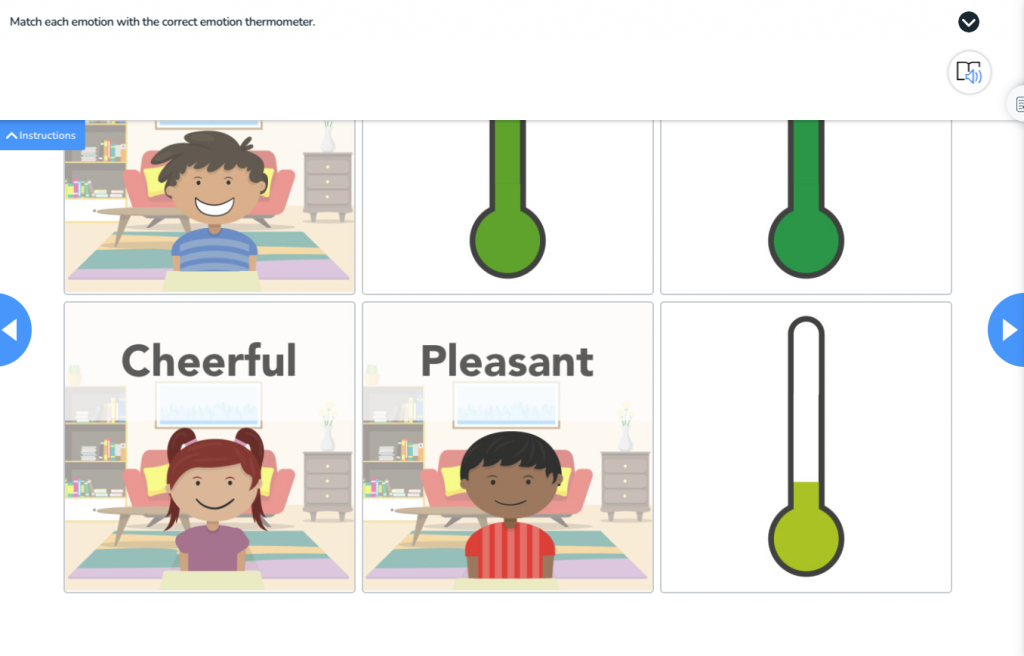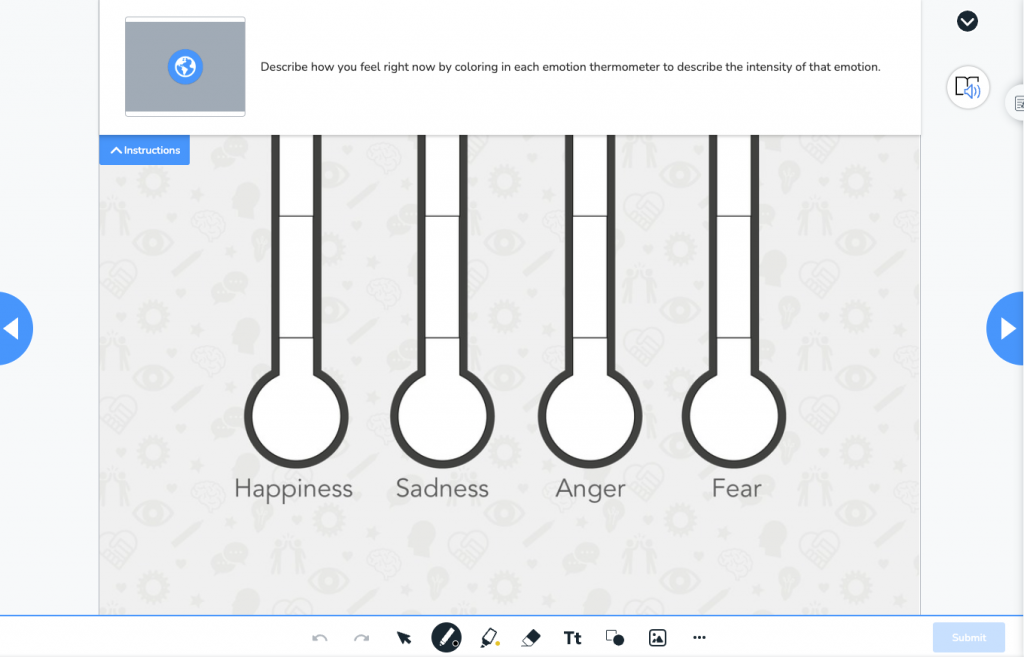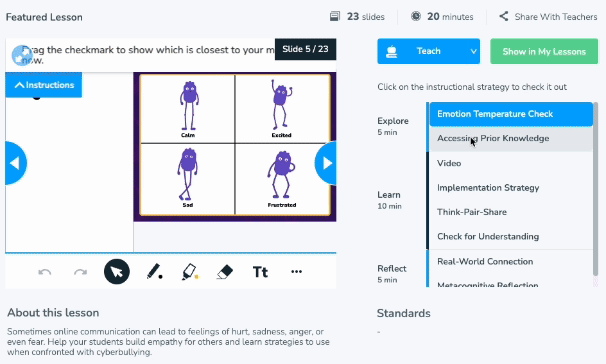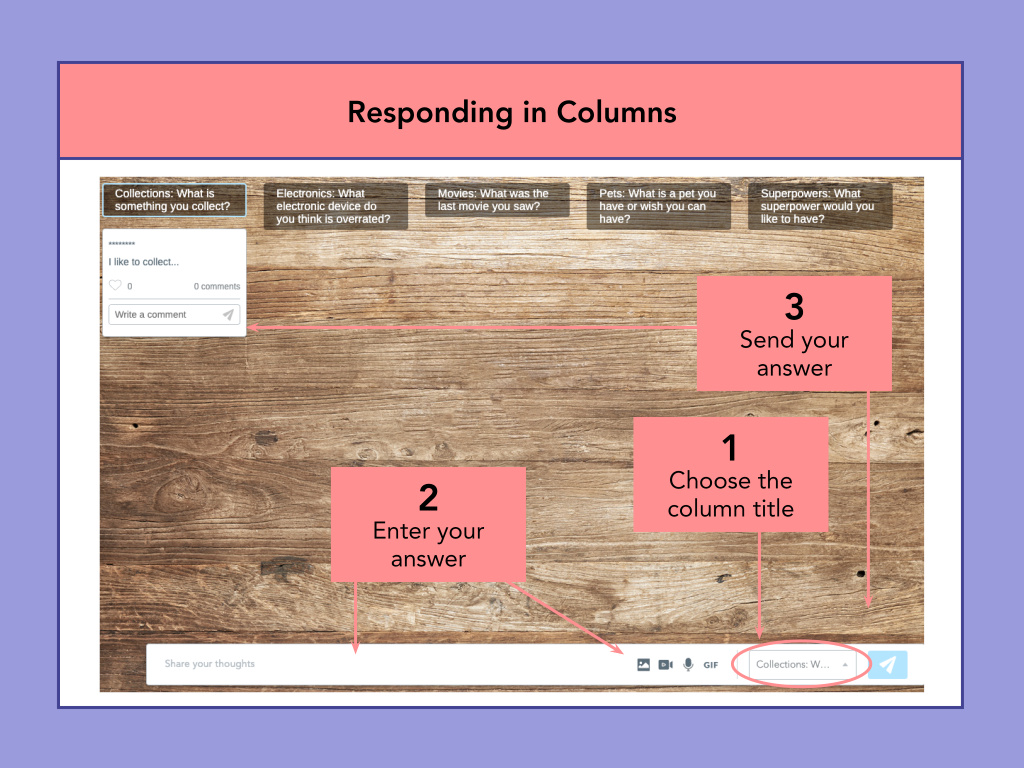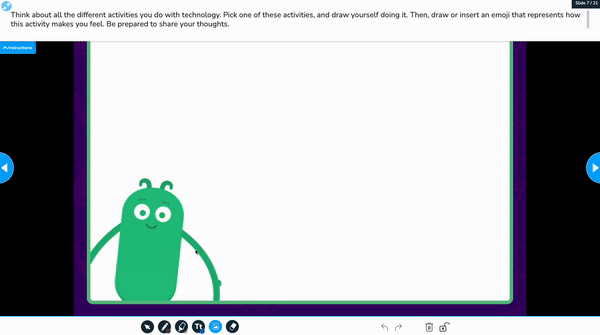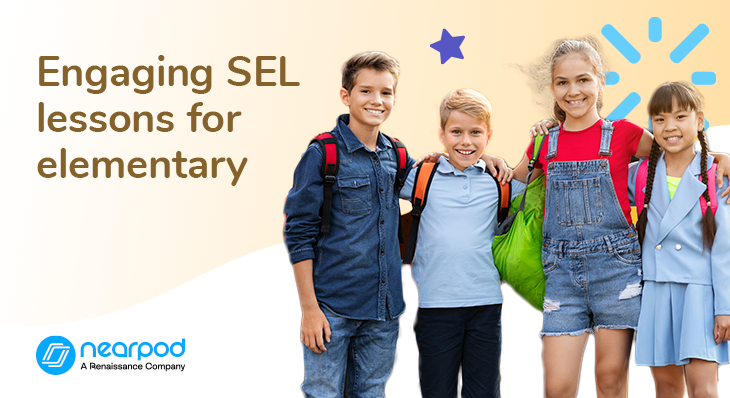
Engaging social and emotional learning (SEL) lessons for elementary students
Why is it important to teach elementary students SEL skills?
No matter what you call it, social and emotional learning (SEL) skills are foundational competencies needed throughout life (and can continue being developed at all ages). Schools have slowly started taking a more inclusive look at which skill sets help define success or future readiness and incorporating them into classrooms. This makes effective SEL lessons for elementary students a fundamental part of their overall education.
The Collaborative for Academic, Social, and Emotional Learning (CASEL), a leading non-profit in the SEL space, defines SEL as “the process through which all young people and adults acquire and apply the knowledge, skills, and attitudes to develop healthy identities, manage emotions and achieve personal and collective goals, feel and show empathy for others, establish and maintain supportive relationships, and make responsible and caring decisions.”
CASEL identifies five interconnected competencies (also known as the CASEL 5 or the CASEL Wheel) that make up the framework of SEL: Self-awareness, self-management, responsible decision-making, relationship skills, and social awareness. Their research underscores how social-emotional skills are key to academic performance, career preparedness, mental health, and healthy relationships.
Social emotional learning in elementary schools is nothing new. While the term has been embroiled in political turmoil, CASEL reports that all 50 states have adopted SEL competencies for pre-K, and 27 states for grades K-12.
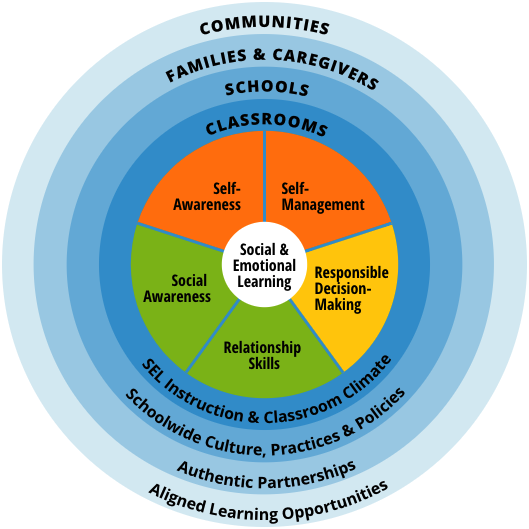
SEL speaks to a whole-child approach in education, where social skills such as communication, cooperation, and active listening, as well as emotional skills such as empathy, resilience, and inclusivity, are taught alongside the core academic objectives. The classroom is the perfect place to start teaching SEL for elementary students, where you strive to create a positive classroom culture and use innovative methodology to encourage kids to learn from and work with one another on a daily basis.
Nearpod’s 21st Century Readiness Program
Nearpod provides a turnkey solution to promote SEL in elementary schools through the 21st Century Readiness Program. There are over 400 lessons, videos, and activities related to SEL alone that encourage a growth mindset and lifelong learning. The 21st Century Readiness Program even qualifies for Federal Title I, II, and IV funds to ensure every student graduates ready to thrive.
If you’re interested in learning more about Nearpod, watch the video below!
New to Nearpod? Teachers can sign up for free below to access and create interactive lessons. Administrators can schedule a call with an expert to explore Nearpod’s 21st Century Readiness Program and unlock the full power of Nearpod for schools and districts!
How to implement social emotional curriculum for elementary students
Introduce students to SEL at a young age
When it comes to effective SEL curriculum, elementary school students are particularly well suited to its lessons. Building SEL competencies at a young age helps children develop skills that will support their academic success, mental well-being, and overall development.
Nearpod offers a robust library of SEL topics designed for K-2 students. The Growth Mindset Practices topic bundles group relevant resources together. They help instill habits that will benefit all learning areas with topics such as asking questions, metacognition, persistence, thinking flexibility, and taking responsible risks. These lessons seek to inspire and empower our youngest students to dream big.
Here are some additional lessons from Nearpod’s lesson library you could use to teach students essential SEL skills:
- Setting Good Goals (K-2): Students practice responsible decision-making and goal setting.
- Share Ideas: Helpful Habits (K-2): Students practice stress
–management with the Draw It activity. - Practicing Mindfulness (K-2): Students practice mindfulness using breathing exercises and other techniques.
Use SEL to start your day
We know instructional time is tight already, so consider ways that you can incorporate SEL activities for elementary students into your existing school day. Do you have a morning routine that SEL can be integrated into? Incorporating social emotional learning activities for elementary students into your bell work can be a simple way of encouraging kids to settle down and prepare for the school day. Morning circle conversations are also a good time to check in and do an informal assessment of how your students are doing and how ready they may be to learn.
Nearpod’s mini lessons can be a good way to start the day. These 10- or 15-minute presentations give students opportunities to explore their emotions, learn from one another, practice previously learned skills, and reflect on their feelings and lessons. In addition to sparking meaningful conversations, they can also give you a quick pulse on your students’ emotions, attitudes, and overall well-being. Try some of these activities in your classroom and add them to your SEL programs’ lesson plans:
- Emotion Thermometer (K-5): Students work on self-awareness and learn to articulate their emotions.
- Temperature Check (2-12): As a warmup, students will use this Collaborate activity to describe their moods and emotions.
- How Do You Feel? (K-2): In this Check-In, students will complete a Draw It activity to share how they feel.
- How Do You Feel? (2-12): In this Check-In, students will complete a Collaborate Board activity to share how they feel.
Focus on friendship
For elementary students, finding and maintaining strong and healthy friendships is an important skill—one that will come into play throughout their lives. Building their interpersonal skills is key to creating and maintaining friendships, and also happens to be one of many important SEL topics for elementary students.
From active listening to conflict resolution, Nearpod offers many lessons and activities that promote patience, clear communication, empathy, teamwork, and other interpersonal skills. These lessons reinforce skills that kids can lean on as they develop new relationships and become participating members of not just your classroom, but society.
- Friendship (K-2): Students discuss how to make friends and be a good friend with the Draw It activity.
- Serving Others (3-5): Students explore how they can serve others in their homes, schools, and communities in this Drag & Drop activity.
- Acting Responsibly (K-5): Students learn how to act responsibly and work on their decision-making skills.
- The Words We Choose (3-5): Students build their sense of empathy and learn strategies for dealing with cyberbullying.
Promote a strong classroom community
You can help build a safe environment for social emotional learning activities for elementary students, by fostering an inviting and inclusive classroom community. Find opportunities for meaningful conversation and classroom dialogue where everyone can have a voice and feel heard. This exchange of ideas can promote respect, trust, and a sense of belonging. Additionally, it encourages positive self-talk, helping students build confidence and resilience while solving problems effectively.
Nearpod’s robust reporting can help you monitor student engagement by keeping an eye on real-time data via any of the nine formative assessment activities. You can also review post-session reports. This will show you which students are active participants, and which might need some additional encouragement. You can then use that data to make informed decisions that will guide your teaching and better reach every student.
Making sure everyone in the classroom is an engaged and active participant means that everyone is a part of the community you’re building. Try these activities to build community in your classroom:
- Building Class Community (K-3): These mini-lessons provide discussion prompts for students around the topic of community.
- Embracing Our Diversity (3-5): Students learn about diversity, why it’s important, and how to build unity.
- Share Something: Conversation Starters (4-12): This Collaborate Board activity encourages students to get to know one another and learn about their different thoughts and opinions.
- Respect (K-3): This quick video covers respect and how to show respect to others.
Weave in digital citizenship
Digital citizenship skills go hand in hand with SEL curriculum. Elementary students who learn how to conduct themselves and treat others offline can carry those skills into online spaces. In our increasingly digital world, digital citizenship skills are more important than ever, and like SEL skills, they should be taught at a young age.
Nearpod has partnered with Common Sense Education to co-create interactive lessons for all grades that reinforce key concepts for digital citizenship. The SEL in Digital Life collection offers interactive lessons, activities, and videos that help equip students with the skills that they will need to navigate the world online. Try these digital citizenship and social emotional learning activities for elementary students:
- Use Your Heart When You’re Online (K-2): Students listen to the Pause & Think Online song to learn about being safe, kind, and responsible online.
- How Can You Be an Online Superhero (3-5): Students evaluate a series of situations and determine how to responsibly handle digital dilemmas.
- My Media Balance (3-5): Students learn how to make healthy media choices and responsible decisions.
Invite families to be part of your SEL initiative
When it comes to any aspect of raising a child, it takes a village. This is true of SEL, too. CASEL emphasizes the importance of families partnering with schools to support kids’ social and emotional learning. After all, families and caregivers are children’s first teachers, making them an essential part of their social and emotional development.
Because SEL wasn’t as explicitly taught in the past, it may be helpful to share research, best practices, and activities with families so that you can present a consistent, positive message with kids. By collaborating with your students’ families, you will help foster a positive school culture with shared values and goals. These social emotional learning lessons for elementary students teach skills that they can use at home as well as at school:
- Time Management (K-2): This lesson covers time management skills and different strategies students can try.
- Staying Organized (K-2): This Check-In activity asks students how they stay organized and practice time management.
- Positive Affirmations (K-5): This lesson uses positive affirmations to remind students of their strengths and build their confidence.
Start using these SEL lessons for elementary
When it comes to SEL during the school years, you could say it’s elementary (get it?) to introduce and revisit concepts and skills early and often. Elementary schools’ self-contained classrooms and thematic curricula make it an optimal setting to highlight social emotional learning for kindergarten and elementary grades (and beyond). These are lifelong skills that will serve them well.
With Nearpod’s 21st Century Readiness Program and social emotional learning curriculum, elementary students are set up for success.
New to Nearpod? Teachers can sign up for free below to access and create interactive lessons. Administrators can schedule a call with an expert to explore Nearpod’s 21st Century Readiness Program and unlock the full power of Nearpod for schools and districts!

Darri Stephens is a dedicated LX (learning experience) designer, passionate about creating quality content and programs for kids, families, and educators. With MAs in Education from both Harvard and Stanford, and work experience at best-in-class ed tech organizations including Wonder Workshop, Nickelodeon, and Common Sense Education, she is steeped in the design thinking process and committed to agile and iterative project management, which has resulted in multi-award-winning programs and products.

